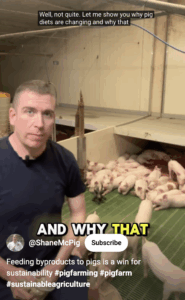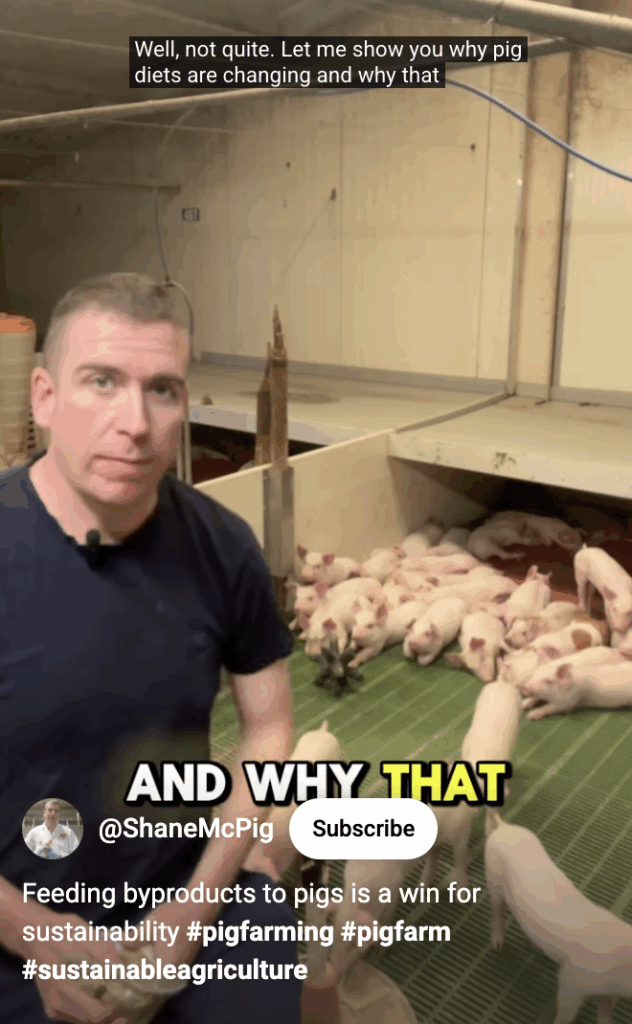When it comes to public engagement, nothing has changed the landscape more than social media. Unlike traditional media, where you rely on a journalist to decide how your message is presented, social media gives farmers full control.
We decide what to show, how to show it, and when. In many ways, it has never been easier for farmers to connect directly with the public and tell our own story.
For many years, I have used Facebook (McAuliffe Pig Farms) and Twitter/X (@ShaneMcAuliffe1) to share what happens on our farms, highlight successes and explain our work. These platforms are a great way to connect with people, both inside and outside the industry.
But in the past few months, I have also started making a real effort with TikTok and YouTube
(@shanemcpig).
This was partly encouraged by the discussions we had at Pigs Tomorrow about the importance of public engagement, and partly by well-known YouTuber The Sheep Shepherd, who visited my farm in July. His video about our farm reached a huge audience, and I was genuinely overwhelmed by all the positive comments online.
On TikTok, I have been trying to take a technical farming topic and break it down into a one-minute video, explaining it in very simple terms. Topics like temperature control or precision feeding can be condensed into clear, engaging clips that anyone scrolling past can understand.
This is where social media really shines: you don’t need fancy editing, a film crew or complicated language. All you need is your phone, a steady hand and a willingness to share.
Block and ignore
Of course, you will sometimes get angry comments, particularly from animal rights activists. My advice is simple: block and ignore.
Y ou will never win an argument with someone who is fundamentally opposed to farming, and it is important to remember that these voices, while loud, are only a tiny minority. The vast majority are curious, supportive and want to understand where their food comes from.
ou will never win an argument with someone who is fundamentally opposed to farming, and it is important to remember that these voices, while loud, are only a tiny minority. The vast majority are curious, supportive and want to understand where their food comes from.
And don’t forget, if comments become too much, you always have the option to disable them entirely. That way you can focus purely on sharing your story without distraction.
Another advantage of social media is that it allows you to engage with the public without compromising biosecurity. Farm visits are fantastic, but they come with real risks, not to mention all the work that goes into organising them, especially if, like me, you always ensure you have plenty of sandwiches available!
A video tour or live Q&A online allows you to showcase your work safely, reaching hundreds or even thousands of people in a way that a single open day never could.
FarmerTime
Speaking of live Q&As, organisations like FarmerTime are also showing how powerful digital connections can be. They link farmers with schools, enabling regular FaceTime calls where pupils can learn about farming directly from those of us on the ground.
FarmerTime needs more farmers to volunteer. It is a simple, effective way of building trust with the next generation, and all it takes is your phone. If you are interested, please contact Tom at: farmertomhaddon@gmail.com
That said, it is important to pause and reflect before hitting ‘post’. Always ask yourself: If an animal rights activist saw this clip, could they twist it to suit their own narrative?
Personally, I don’t share too many images or videos of farrowing crates. Farmers know crates are used to protect piglets and improve survival rates, but for a member of the public unfamiliar with pig farming, seeing a sow unable to turn around is difficult to explain.
Social media is also a platform for advocacy. Farmers can use it to highlight the real challenges we face, such as rising input costs or policy pressures, and to call for government support when needed.
You may be surprised at how many members of the public respond with empathy and even take action to support farmers when they understand the challenges behind food production.
Finally, remember that people love to see the family side of farming. A short clip of family members working together, or even a video from the kitchen table showcasing a tasty ‘Put British Pork on Your Fork’ recipe, can have just as much impact as technical updates from the farm office.
Pork is such a versatile and nutritious food, and showcasing it in a fun and relatable way helps connect consumers with the end product.
In the end, social media is what we make of it. It can be a distraction, or it can be the single most powerful tool for public engagement that farmers have ever had.
By using it wisely to educate, advocate and celebrate, we can make sure the story of farming is told by those who know it best: the farmers themselves.




